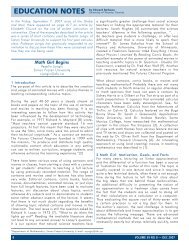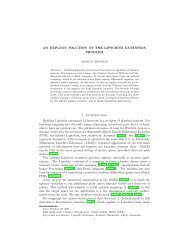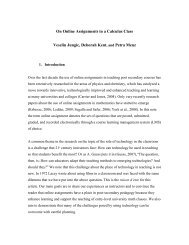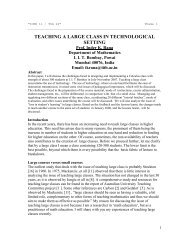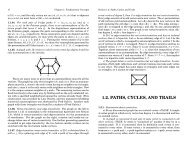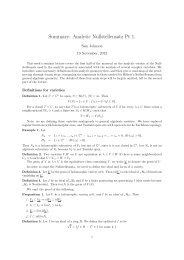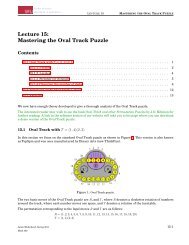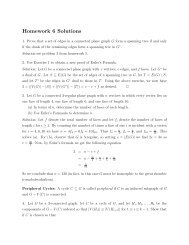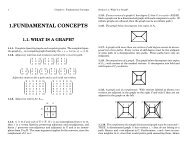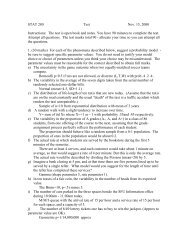Lecture 4: Permutations: Cycle Notation - People.stat.sfu.ca
Lecture 4: Permutations: Cycle Notation - People.stat.sfu.ca
Lecture 4: Permutations: Cycle Notation - People.stat.sfu.ca
You also want an ePaper? Increase the reach of your titles
YUMPU automatically turns print PDFs into web optimized ePapers that Google loves.
Week Date Sections<br />
from FS2009<br />
Part/ References Topic/Sections Notes/Speaker<br />
1 Sept 7 I.1, I.2, I.3 Combinatorial Symbolic methods<br />
2 14 I.4, I.5, I.6<br />
Structures<br />
FS: Part A.1, A.2<br />
Unlabelled structures<br />
3 21 II.1, II.2, II.3<br />
Comtet74<br />
Handout #1<br />
Labelled structures I<br />
4 28 II.4, II.5, II.6<br />
(self study)<br />
Labelled structures II<br />
5 Oct 5 <br />
1<br />
III.1, III.2<br />
2 3 4<br />
Combinatorial<br />
parameters <br />
FS 5A.III<br />
Combinatorial<br />
Parameters<br />
6 12 IV.1, IV.2 (self-study)<br />
Multivariable GFs<br />
α =<br />
Asst #1 Due<br />
7<br />
8<br />
9<br />
19 IV.3, IV.4<br />
(a) array form<br />
26<br />
IV.5 V.1<br />
Nov 2<br />
Analytic Methods<br />
FS: Part B: IV, V, VI<br />
Appendix B4<br />
Stanley 99: Ch. 6<br />
Handout #1<br />
Complex Analysis<br />
Singularity Analysis<br />
Asymptotic methods<br />
Asst #2 Due<br />
9 VI.1<br />
(self-study)<br />
Sophie<br />
10<br />
12 A.3/ C<br />
Introduction to Prob. Mariolys<br />
11<br />
12<br />
20 IX.2 Random Structures<br />
and Limit Laws<br />
Discrete Limit Laws Sophie<br />
23 IX.3<br />
FS: Part C<br />
(rotating<br />
presentations)<br />
Combinatorial<br />
instances of discrete<br />
Mariolys<br />
25 IX.4 Continuous Limit Laws Marni<br />
13 30 IX.5<br />
f aculty of science MATH 895-4 Fall 2010<br />
department of mathematics Course Schedule<br />
LECTURE 4 PERMUTATIONS: CYCLE NOTATION<br />
2 3 4 5 1<br />
(b) arrow form (c) cycle-arrow form<br />
Figure 1: Different representations for a 5-cycle.<br />
Quasi-Powers and<br />
Gaussian limit laws<br />
Sophie<br />
α = (1, 2, 3, 4, 5)<br />
(d) cycle form<br />
Though mathemati<strong>ca</strong>lly satisfactory, the cycle arrow form is cumbersome to draw. However, leaving<br />
18 IX.1 Limit Laws and Comb Marni<br />
out the arrows we <strong>ca</strong>n simply write the 5-cycle as:<br />
α = (1, 2, 3, 4, 5)<br />
This represents that fact that α maps each number to the next one in the list, and maps 5 back<br />
around to the start of the list, which is 1. This representation is shown in Figure 1d.<br />
All 14 representations Dec 10 in Figure Presentations 1 have their own benefits, Asst #3 Due but it is the cycle notation that is the most<br />
compact, and this will be the notation we primarily use in this course.<br />
When working with cycle notation, α = (1, 2, 3, 4, 5), you should read it as follows:<br />
“1 goes to 2, 2 goes to 3, 3 goes to 4, 4 goes to 5, and 5 goes to 1.”<br />
We don’t need to start at 1 when writing down the cycle form, if we started at 3, for instance, and<br />
constructed the list of numbers we visit by traveling around Figure 1c then we get (3, 4, 5, 1, 2). This is<br />
Dr. Marni MISHNA, Department of Mathematics, SIMON FRASER UNIVERSITY<br />
Version another of: 11-Dec-09 perfectly acceptable representation of α: reading this cycle notation as described above will<br />
tell us exactly how α acts as a function. In particular, we <strong>ca</strong>n represent α by any of the equivalent<br />
cycle forms:<br />
α = (1, 2, 3, 4, 5) = (2, 3, 4, 5, 1) = (3, 4, 5, 1, 2) = (4, 5, 1, 2, 3) = (5, 1, 2, 3, 4).<br />
Despite this notation allowing for non-unique representations of permutations, there is an easy fix.<br />
Just writing the cycle so that the first number is the smallest number in the cycle. In this <strong>ca</strong>se we<br />
would then write α = (1, 2, 3, 4, 5) since 1 is the smallest number in this cycle.<br />
Let’s look at another permutation: β =<br />
Jamie Mulholland, Spring 2010<br />
Math 302<br />
1 2 3 4 5 6 7 8<br />
3 2 7 8 1 4 5 6<br />
<br />
. The cycle arrow form is:<br />
2



